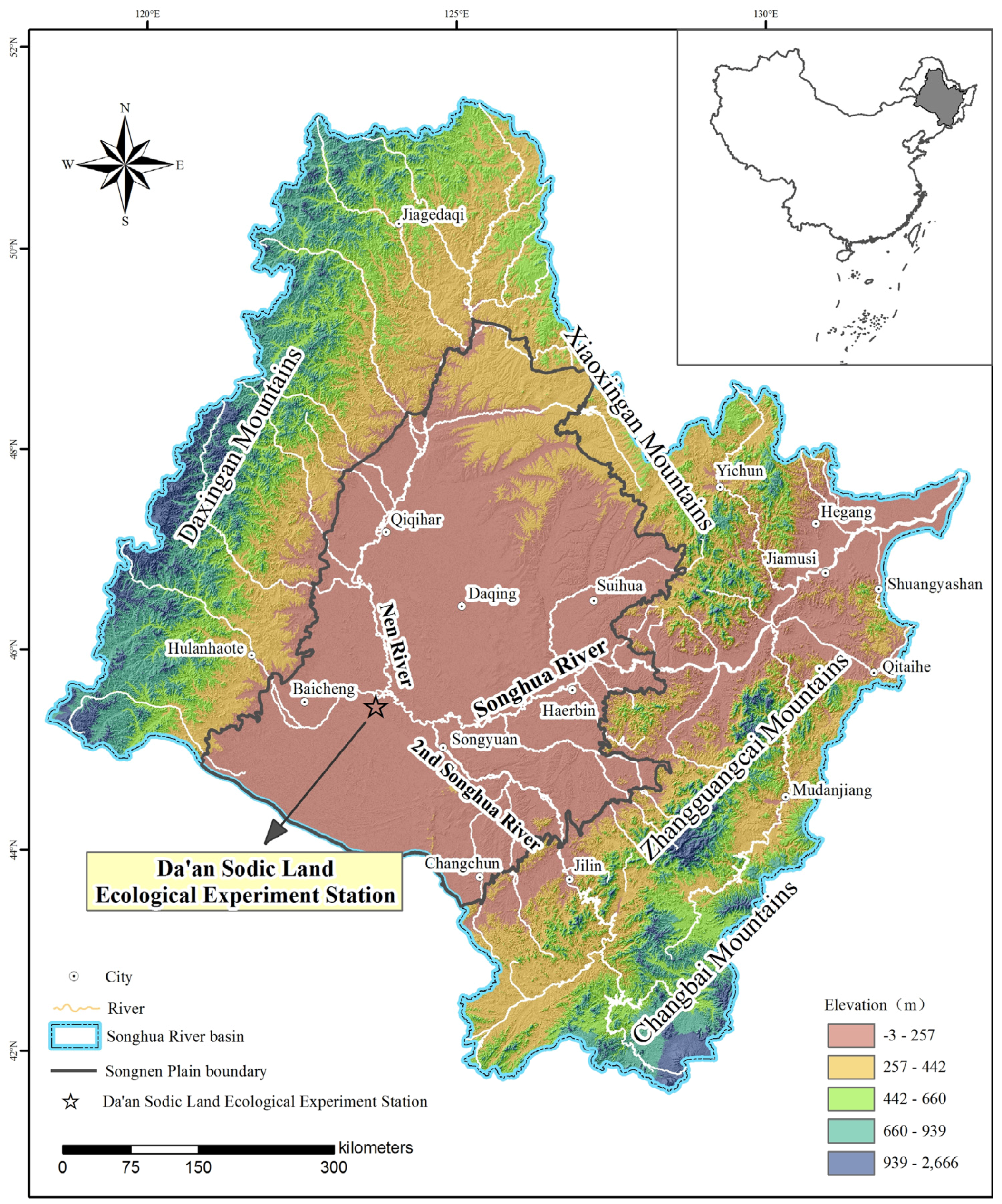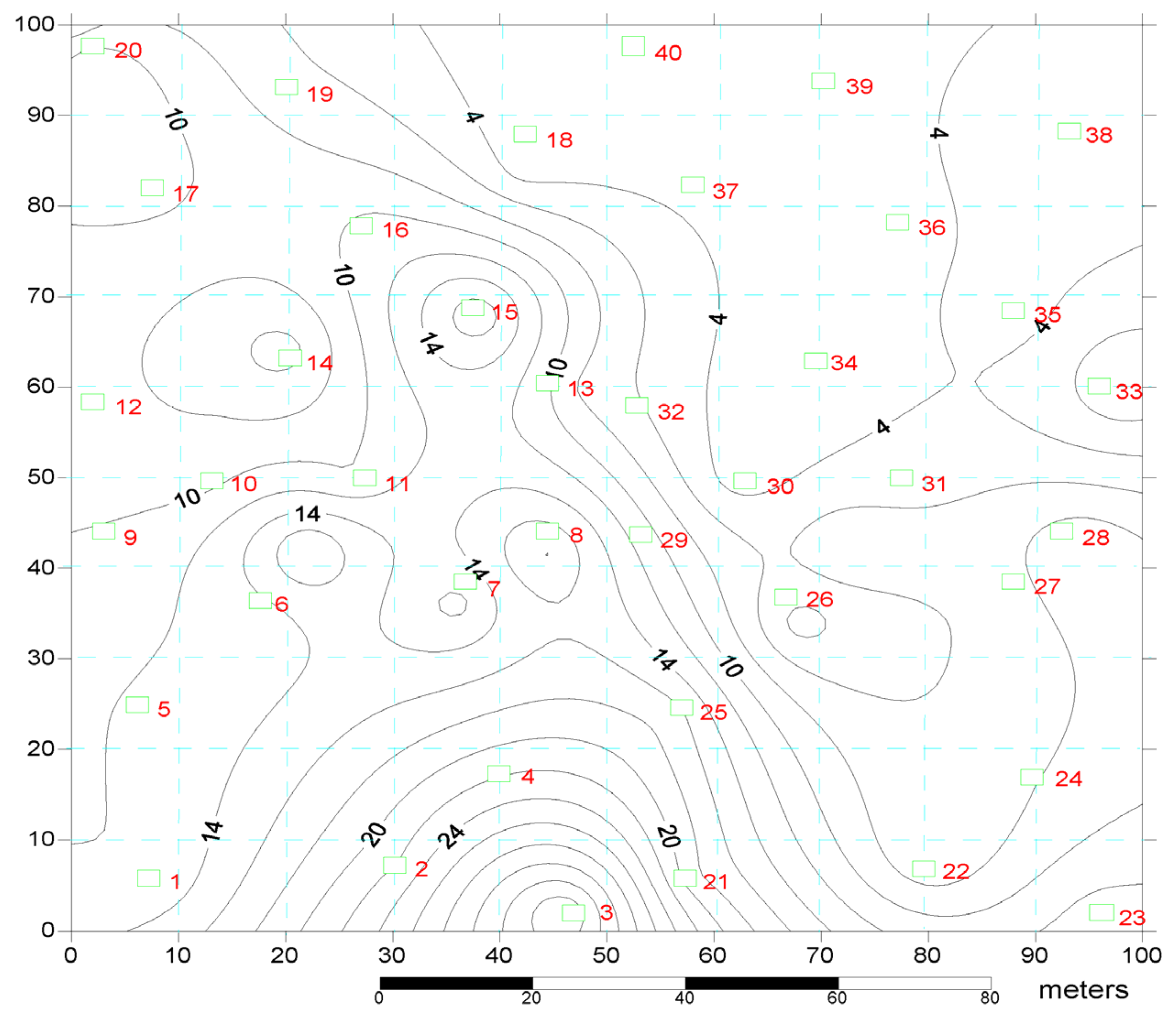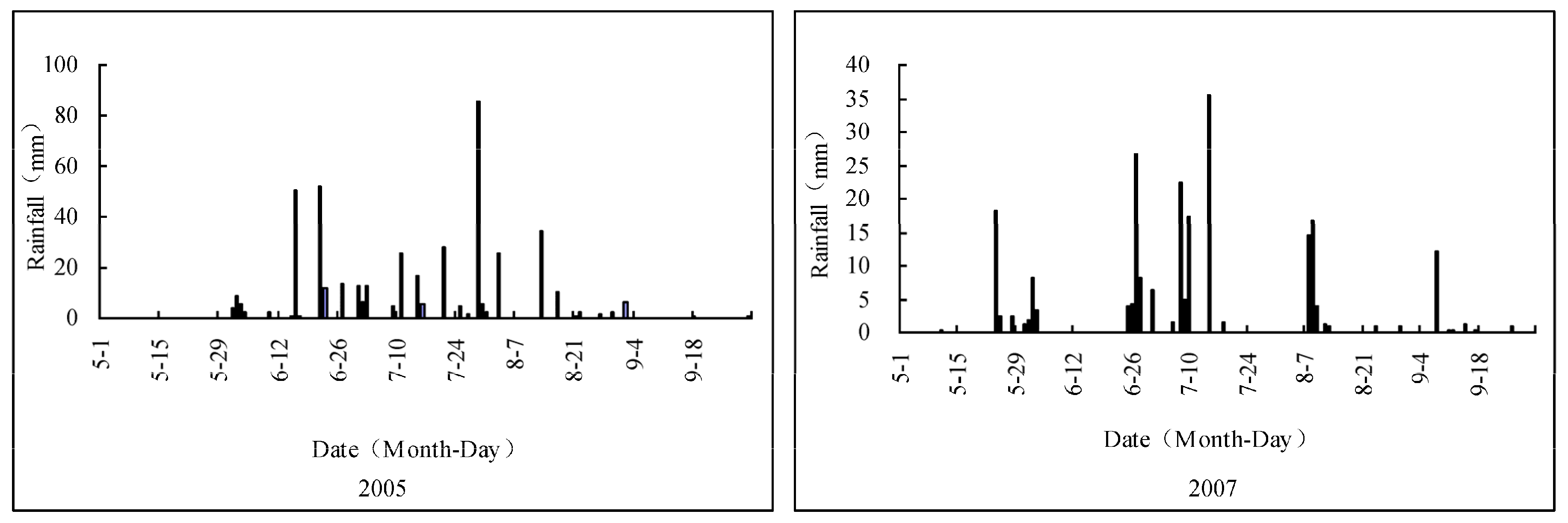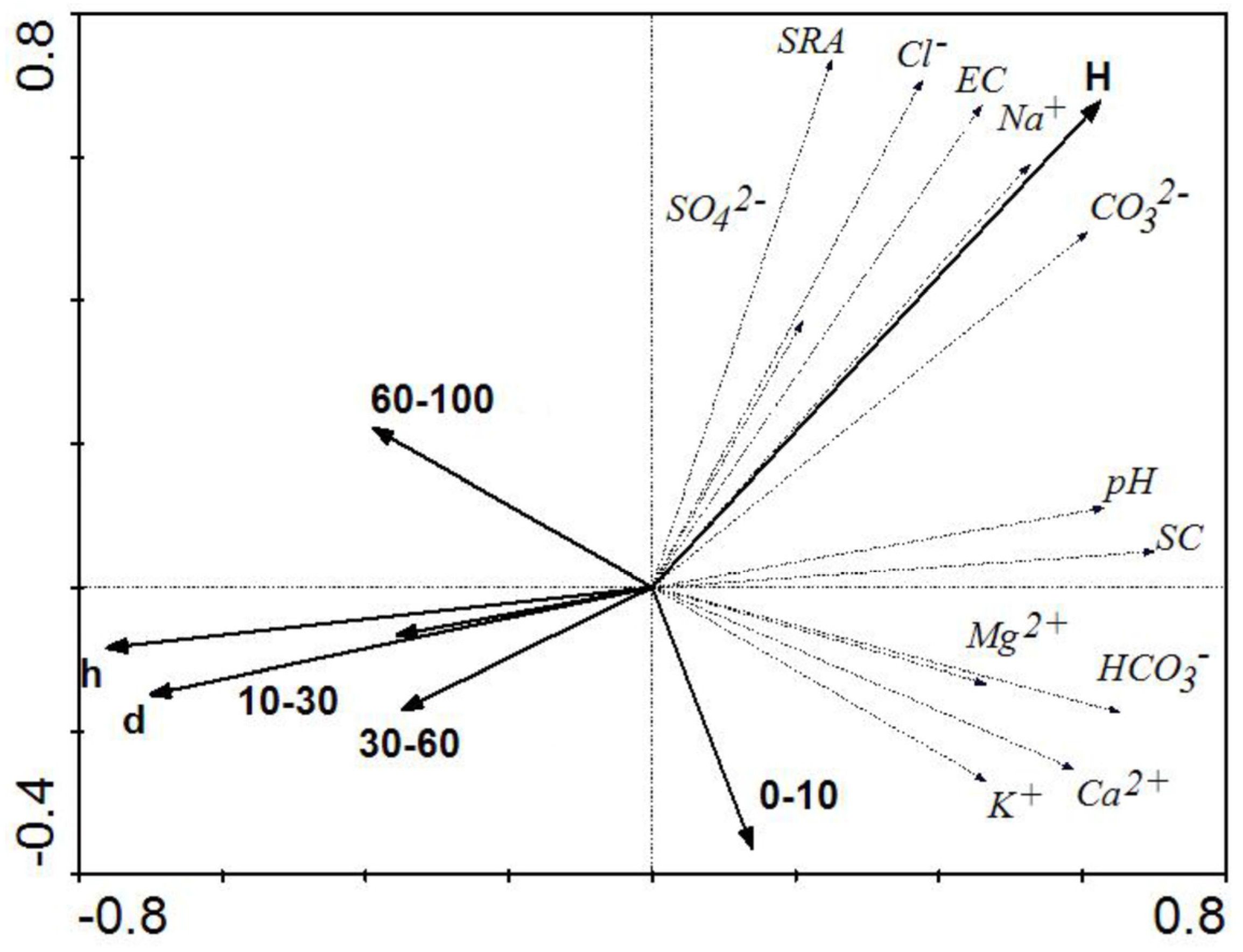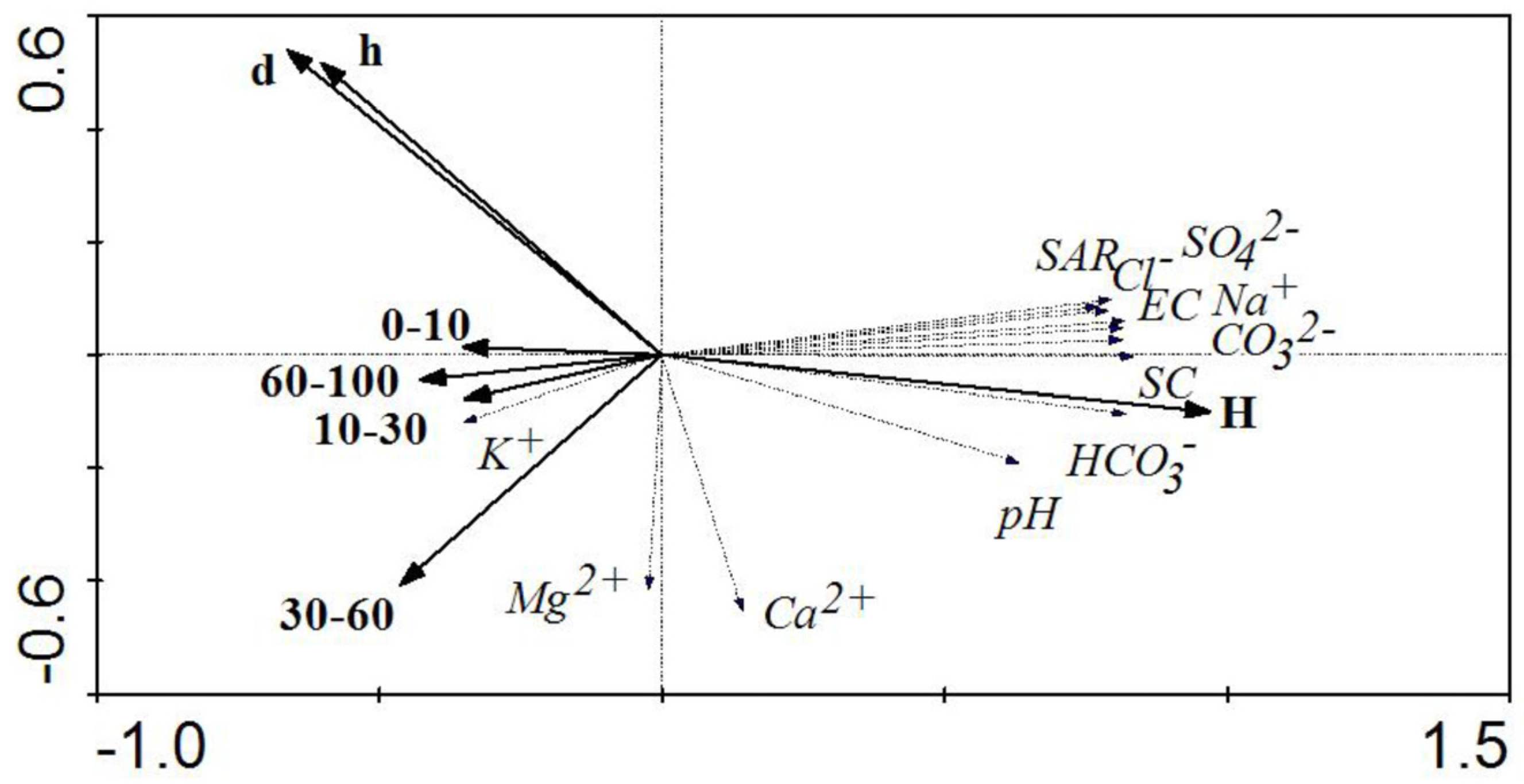3.2. Comparison of Surface Soil Salinity–Sodicity Parameters between Wet and Dry Years
The descriptive statistics of soil ion contents and associated properties at the soil layer (0–10 cm) at these 40 measurement points are given in
Table 1. The content of Na
+ was significantly higher than other cations with a mean of 809 mg/kg in wet year (2005) and 1238 mg/kg in dry year (2007) (
p < 0.05), and the content of HCO
3− was significantly higher than other anions with a mean of 3369 mg/kg (2005) and 1583 mg/kg (2007), respectively (
p < 0.05) (
Table 1). The mean pH value in 2005 and 2007 were 9.51, and 9.48, respectively. Soil alkalinity is associated with the presence of sodium carbonates (Na
2CO
3) or sodium bicarbonate (NaHCO
3) in the soil, so the extracts were alkaline or strongly alkaline.
Variation coefficient (CV) was the most important factor in describing the distribution and variability of soil property. Spatial variation can be divided into three categories: high spatial variation (CV > 1), moderate spatial variation (0.1 < CV < 1), and low spatial variation (CV < 0.1) [
28]. Experimental results indicated soil soluble salts and their chemical properties displayed high and moderate spatial variations except the pH. The calculated coefficients of variation for soil ion ranged from 34% to 203%. CV value for EC, SAR, and SC are from 74% to 197%. CV values of Na
+, CO
32−, SO
42−, SAR and EC were relatively higher under dry weather condition (2007) than wet weather condition (2005) (
Table 1).
Parameter values of SAR, Cl
−, and SO
42− were significantly higher in dry year (2007) than in wet year (2005) (
p < 0.05), while Ca
2+, Mg
2+, K
+, and HCO
3− showed the opposite results (
Table 1). There were no significant differences in parameter values in EC, SC, Na
+, and CO
32− between these two years. Because of high CV values for these parameters (CV > 1), soil salinity–sodicity in different ground elevation may be different under microtopography [
10,
15]. To further evaluate the impact of ground elevation gradient on these soil salinity–sodicity parameters (EC, SC, Na
+, and CO
32−) between dry and wet weather conditions, ground elevation was divided into three gradients: 0–10, 10–20, and 20–40 cm. Results of comparison of these parameter values between dry and wet years at each ground elevation gradient are given in
Table 2. Ground elevation had significant impact on these soil salinity–sodicity parameters (Na
+, CO
32−, EC, and SC) (
Table 2). Parameter values of Na
+, CO
32−, SC, and EC showed significant differences between dry and wet years only at higher ground elevation (20–40 cm): values of Na
+, CO
32−, SC, and EC were significantly higher in dry year (2007) than wet year (2005) (
Table 2). While parameter values of SC were significantly lower in dry year (2007) than the wet year (2005) at middle and lower ground elevation gradients (10–20 cm and 0–10 cm). Thus, high evaporation and low rainfall can increase soil salinization in soil surface layer (0–10 cm), especially at higher ground elevation gradient in dry climate condition.
3.3. Relationship between Surface Soil Salinity–Sodicity and Environment Factors
The RDA was used to analyze the relationship between surface soil salinity–sodicity and environmental factors based on the soil salinity–sodicity data matrix and an environmental data matrix. The connection between soil salinity–sodicity of the sample plots and the measured environmental factors in the study area as revealed by RDA are shown in
Table 3. The results showed that 51.6% of soil salinity–sodicity spatial distribution was explained by these seven environment variables (sum of all eigenvalues is 1.0; sum of all canonical eigenvalues is 0.516) during the wet year, whereas 68.8% was explained during the dry year (sum of all eigenvalues is 1.0; sum of all canonical eigenvalues is 0.688). In addition, the cumulative variance explained for the first two ordination axes accounts for 100% of total cumulative variance. The research objects, environmental correlations, are higher for the first canonical axes, explaining 94.6% and 99.8% of the total cumulative variance in the wet and dry year, respectively (
Table 3). Hence, these seven environment factors selected may, to a large extent, explain the spatial distribution of soil salinity–sodicity, by the first two ordination axes during different hydrological years. Through the above analysis, it is evident that the two ordination axes can describe the spatial distribution of the soil salinity–sodicity. These seven environment factors are able to explain the distribution characteristics of the surface soil salinity–sodicity by the first ordination axes, especially under dry weather conditions.
Monte Carlo permutations (499 iterations) were performed to test for significant relationship between soil salinity–sodicity data and the canonical axes. Results indicated that all canonical axes were significant (
p = 0.002). From the intra-set correlations of the environmental factors with the axes of the RDA shown in
Table 3, it can be seen that the selected environmental factors were mainly correlated with the first axis. During the wet year, there was significant relationship between environmental factors (ponding depth, ponding time and ground elevation) and the first axis (
r = −0.5281, −0.4864 and 0.4339, respectively) (
p < 0.05) while soil moistures at all four soil layers showed no significant relationship with the first axis (
Table 3). Under wet year, ground elevation showed significant positive relationship with both the first and second axes (
Table 3). The results showed surface ponding and microtopography were key factors, which affect distribution and variation of surface soil salinity–sodicity in wet year. During dry year, all environmental parameters showed significant relationship with the first axis except soils moistures at the upper layer (W
0–10 and W
10–30) (
Table 3), which has also been revealed by the RDA ordination biplots (
Figure 3 and
Figure 4). Therefore, microtopography, surface ponding and soil moisture in deep soil layer are the significant factors affecting the distribution of salinity and sodicity in the soil during the dry year.
The relationship between parameters of soil salinity–sodicity and environment variations were analyzed using RDA and Pearson correlation analysis method. During the wet year, soil salinity–sodicity parameters (Na
+, CO
32−, Cl
−, EC, SAR, pH, and SC) were all positively correlated with ground elevation (
Table 4 and
Figure 4). Soil salinity–sodicity parameters (Na
+, Ca
2+, CO
32−, Cl
−, HCO
3−, EC, pH, and SC) were negatively correlated with ponding time and ponding depth (
Table 4 and
Figure 4). There is an increase in soil ions (Na
+, CO
32−, and Cl
−) at the upper part of microtopography (mound). For Ca
2+, Mg
2+ and HCO
3−, they are richer at the middle part of microtopography than upper and lower part. SAR and EC values increase with the increase of ground elevation. SAR and EC were the highest at upper part of microtopography (
Table 2 and
Figure 3). However, during the dry year, surface soil salinity–sodicity parameters (Na
+, CO
32−, Cl
−, HCO
3−, SO
42−, EC, SAR, pH, and SC) were all positively correlated with ground elevation (
Table 4 and
Figure 4). Surface soil salinity–sodicity parameters (Na
+, CO
32−, Cl
−, HCO
3−, SO
42−, pH, SC, and SAR) were negatively correlated with ponding time and ponding depth, and were negatively correlated with soil moistures (soil layer: 30–60 cm and 60–100 cm) (
p < 0.05) (
Table 4 and
Figure 5). The results indicated that spatial distribution and variations of soil salinity–sodicity in surface soil layer were related with ponding and microtopography in wet year, and they were related with ponding, microtopography, and moisture at deep soil layer in dry year. High values of surface soil salinity–sodicity are found at the upper part of microtopography (mound). Moderate values of salinity and sodicity are found at the middle part of microtopography. Mild value of salinity and sodicity are observed at the lower part of microtopography (depression). Surface soil salinity–sodicity was severe in dry year than wet year, especially at the upper part of microtopography.
3.4. Key Factors Affecting Spatial Distribution of Surface Soil Salinity–Sodicity
It is often of great interest to rank environmental variables in their importance for determining the surface soil salinity and sodicity distribution and variation. In the RDA analysis, Monte Carlo was used to determine the significance of each environment factor. The marginal effects of all environmental variables (
i.e., the independent effect of each environmental variable) and conditional effects (
i.e., the effect that each variable brings in addition to all the variables already selected) are shown in
Table 4 and
Table 5. During the wet year, ponding depth (h) is the most important environmental factor, which explains 56% of the spatial variation in the total cumulative variance, and ground elevation (H) is the second key environmental factor, which explains 16.7% of the spatial variation in the total cumulative variance. Results indicated that ponding depth and ground elevation, are the most important environmental factors affecting the spatial distribution and variation of soil salinity–sodicity in the wet year. Under dry year (2007), ground elevation (H) and soil water content at 60–100 cm soil layer (W
60–100) are the key environmental factors (
Table 6), which explain 83.8% of the spatial variation in the total cumulative variance together. During dry year, ground elevation is the most important environmental factor, which explains 67.4% of the spatial variation in the total cumulative variance, and W
60–100 is the second key environmental factor, which explains 16.4% of the spatial variation in the total cumulative variance. Hence, in wet year, primary and secondary influence factors on the spatial distribution of surface soil salinity–sodicity are ponding and microtopography, separately. But in dry year, primary and secondary influence factors are microtopography and soil moisture in deep soil layer, separately. Soil moisture in deep soil layer is mainly supplied by shallow groundwater. Therefore, distribution of soil salinity and sodicity is affected by both microtopography and shallow groundwater, but the effects of the shallow groundwater are relatively lower than that of microtopography. Results from this research are consistent with other studies. Yang
et al. [
29] found influence of capillary rise from shallow groundwater was less important due to aggravation of soil salinization. Luo
et al. [
10] reported that the ground elevation has more effects on soil salinization than that of underground water.
Microtopography affects hydrological processes in local scale, and affects the distribution and variations of surface soil salinity and sodicity, which in turn affects the movement of soil water and salts. Low level of soil salinity–sodicity was found to be located in the depressions. Similar results have been documented by Kilic
et al. [
30]. Level of soil salinity–sodicity was observed to increase with the increase of ground elevation. Soil salinity–sodicity is aggravated due to the increase of Na
+ and SAR. Soil tended to disperse due to the existence of excessive sodium. High sodicity degraded the soil physical properties, and caused soil compaction and slow internal drainage and the reduction of soil water storage and poor aeration [
1,
2,
31]. The permeability of the upper soil is extremely low with saturated hydraulic conductivity less than 1 mm/day at the ground elevation of 10–40 cm [
32]. Effective soil depth affected by rainfall and evapotranspiration was found not to exceed at 40 cm soil layer, and the shallow groundwater had slight effect on soil water contents above the depth of 80 cm soil layer [
29]. Hence, the vertical movement of water (capillary rise and infiltration) is comparatively slow due to the aggravation of soil salts. Because of mild salinity and sodicity located in the depressions, soil physical properties were improved compared to the mound. In addition, owing to the difference in plant distribution, the infiltration capacity is higher in the depressions than in the mounds. Depressions were covered by
Phragmitesaustralis due to seasonal waterlogging. Roots are intricately crossed and extended to 60 cm in the soil profile [
33]. The advanced root system of
Phragmitesaustralis can create more active soil pores, which in turn will increase the infiltration capacity [
34].
Salts, derived from ponding and soil weathering reactions, accumulate in the surface of zones in the soil profile. This salinity fluctuation also changes with reason and rainfall [
35]. In wet year, runoff with salt from mound flows into the depression due to of the excessive rainfall in rainy season. Because of higher infiltration capacity in the depressions, which can infiltrate a lot of salts into the deep soil or shallow groundwater to form desalination water layer. Thus, depressions were salt water exchange places. In a dry year, because the upper part and middle part of microtopography has higher temperature than that at lower part [
10], the evaporation at the upper part and middle part of microtopography is higher than that at lower part. In the dry year, the evaporation shows relatively higher impact than the wet year. Based on the principles that the soil water flows from high to low gradient, soil moisture at the upper part and middle part of microtopography is supplied with water from the depression by side direction moving of moisture from low elevation to high elevation. During the process of side movement of moisture from low elevation to high elevation, the salts were also transported and accumulated through evaporation. The higher the evaporation, the faster the moisture is supplied, and the more the salt is accumulated. Low rainfall and high evaporation can increase the salt contents at the surface soil, especially at the upper part and middle part of microtopography [
15]. The microtopography could influence the pattern and magnitude of spatial variability in salinity and alkalinity [
36]. Therefore, under arid climate, the side direction movement of soil water driven by water with soluble salts from depression is the key factor, which aggravates the soil salinization under microtopography in dry condition.
Based on research of mechanism of soil salinization formation and its development, it is found that the side direction movement of soil water driven by ponding water under microtopography in dry conditions is the key factor which aggravates the soil salinization, which will lead to co-distribute high saline and sodic areas and non or low saline and sodic areas at different part of microtopography. Most of the traditional saline-sodic soil reclamation approaches are only effective for saline-sodic soils with good uniformity in ground elevations. Therefore, these approaches may not work in areas with spatial variations in ground elevations, where there are also high spatial variations in soil salinity–sodicity.
Continuous cropping was suggested together with good surface water drainage and improvement of soil structure prior to cropping was found to be beneficial [
1]. The best way to ameliorate saline-sodic soil for the Patch with salinization involves increase in Ca
2+ on the cation exchange site at the expense of Na
+. The replaced Na
+ together with excess soluble salts is removed from the root zone through infiltrating water as a result of excessive irrigations to achieve soil improvement.
